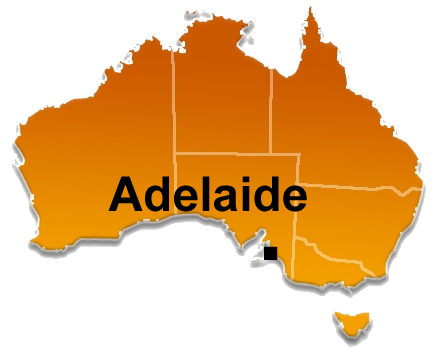First stop is Adelaide.

Adelaide is the capital city of South Australia. It was originally established in 1836 as a city for free European settlers in the old colony. It is located on the River Torrens. It contains a population of 1.23 million people, which is a whopping 77% of the population of South Australia.
Adelaide was known for being quite a progressive town in its early days, giving religion and culture space to exist unhindered. As such, Adelaide is colloquially known as the "City of Churches", owing to the fact there are churches of pretty much every flavour you can think of having a presence there. It is also quite a cultural hub, with many music festivals happening either annually or biennially, including the Adelaide Fringe Festival and the WOMADelaide world music festival, among others.
The nearest capital city is Melbourne, 654 kilometres to the south east, with which is shares a fierce rivalry on the football (Aussie Rules, thank you very much!) field.
Adelaide also has a reputation for being a working class city, with many manufacturing industries based there, starting with boat building in the early 1900s and, until recently, automobile manufacturing.
Adelaide was a hive of activity during the mass migration period of the late 1950s and 1960s courtesy of the 10 Pound migration scheme. Like many other areas of Australia, "10 Pound Poms" moved in with their young families for a new life, and with plenty of opportunities for work. Many of the children of these families came of age right at the time The Beatles exploded onto the music scene, and the in-thing to do was to form a band. Being a cultural hub of sorts, there were plenty of places to play gigs in Adelaide, if you were any good.
From the 1960s onward, Adelaide has given us many great musicians and artists. On the serious side, Percy Grainger was born here (the writer of "English Country Garden" among many many other tunes), plus also Australian Idol winner Guy Sebastian, and children's entertainer Patsy Biscoe come from here.
Over the next few posts we'll take a look at some of the memorable acts that have formed in Adelaide.
The Twilights
The Twilights were a band made up of British Immigrants living in the working class satellite town of Elizabeth. The were formed in early 1965 and had a number of big hits until their breakup in 1969. The band is notable for the first public appearances of Glenn Shorrock, who went on to front Axiom and the Little River Band, as well as Terry Britten, who has been a songwriter-for-hire for the likes of Michael Jackson, Tina Turner and Cliff Richard. "Needle In A Haystack" was their only number 1 hit, released in 1966.
Zoot
Zoot started out in Adelaide as a beat group playing Mod covers, but were persuaded to change their image radically with the marketing campaign "Think Pink - Think Zoot". Their early singles watered down their tough mod stance but they then upped the ante when they discarded the pink and introduced a new guitarist, a young Rick Springfield. Rick was responsible for turning up the amps and radically re-working existing tunes, like "Eleanor Rigby" by the Beatles (see below). The band also featured a future Little River Band member Beeb Birtles and future solo pop star Darryl Cotton.
Masters Apprentices
The Master's Apprentices started as a tough R&B group in the mold of Them or The Rolling Stones. They started life as an instrumental band in the mold of the Shadows in the early 1960s, but after the Beatles hit big, every instrumental band went scurrying for a singer. The Mustangs found Jim Keays and turned into a heavy blues band called Master's Apprentices. They had a genius guitarist in the form of Mick Bower, who had composed all their early hits, and right when the band were hitting their stride, he had a nervous breakdown before a gig in Tasmania and he quit the band. They struggled through a number of lineup changes before settling on Doug Ford as a guitarist. The had a second lease on life and produced some of the most enduring Australian classics before calling it a day in 1972. Jim Keays had a moderately successful solo career. Doug Ford disappeared to England somewhere and bassist Glenn Wheatley went on to manage the career of Little River Band, and later Moving Pictures and John Farnham.
The Angels
The Angels started life in Adelaide as the Moonshine Jug and String Band, before going electric as "The Keystone Angels" and then just The Angels in 1976. They feature the mad Irishman Doc Neeson on vocals, whose stage performances are a sight to behold. (Rumour has it that Doc once offered to manage the career of the aforementioned band Zoot). Wildly successful in Australia, they have attempted to succeed in America but have struggled due to management and label pressures and, of course, their name. They had to change it to "Angel City" to avoid being confused with a 60s girl group The Angels (who'd had a hit with "My Boyfriend's Back" circa 1960) and a glam metal band of the period called Angel. They tried again in 1989 as "The Angels From Angel City" but they weren't altogether successful then either. Still, the track "Marsellaise" still gets played on rock radio in the US and Pearl Jam, Guns and Roses and Nirvana have all cited the band as an influence.

No comments:
Post a Comment